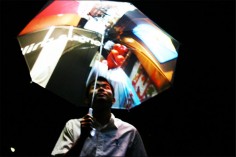SHO HASHIMOTO AND TAKASHI MATSUMOTO
pileus: internet umbrella
source: pileus
Pileus is an umbrella connected to the Internet to make walking in rainy days fun. Pileus has a large screen on the top surface, a built-in camera, a motion sensor, GPS, and a digital compass. The current prototype has two main functions: photo-sharing and 3D map navigation.
The photo function is connected to a major web service: Flickr API. A user can take photo with a camera on the umbrella, and pictures are uploaded to Flickr in two minutes with context tags via a wireless Internet connection. User can also enjoy theirselves watching photo-streams downloaded from Flickr with simple operation of wrist snapping.
It also has a function of 3D Map. Detecting a location data from GPS, it shows a 3D bird view around the user. User can walk-through a city comparing the 3D views and real sights, and the map is always updated by GPS and a digital compass. It aims to create natural augmented reality with a large informatin screen on the umbrella.
These two functions can be switched by simply fliping a switch. As a future direction of its development, putting a context data on the Internet (e.g. geo-tags on photos), it will be able to provide social local-navigations and real-time in-place communications. The product aims to provide an augmentation of everyday life synchronizing information on the Internet and the real place.
.
.
.
.
.
.
.
source: pcmag
What if you could snap a photo or shoot video using just your umbrella? That’s what Sho Hashimoto, Shingo Iwata, and Takashi Matsumoto are developing with Pileus: The Internet Umbrella. The Pileus system is described as a “mobile tangible browser to make rainy days fun.” The umbrella is Wi-Fi-enabled with a built-in camera. A Pileus user can take a picture or video using the umbrella, and the media is uploaded to Flickr or YouTube. Then, the user can twist the handlebar, which contains an RFID reader, to scroll through the content on each site. The media content is projected onto the umbrella’s underside. The team also hopes to integrate GPS sensors into the umbrella to be used as a navigational system.
.
.
.
.
.
.
.
.
source: popxpop
昔からあまり進化していないものとしてよく挙げられるのが「傘」。
しかし慶応大学で研究されている『The Internet Umbrella』は違う意味ですごい進化を遂げています。
雨をよける、という機能はそのままですが、雨の日が楽しくなる仕掛けを傘に搭載してしまいました。
さてどのような仕掛けなのでしょうか。以下に詳しくご紹介。
彼らが研究しているのは「The Internet Umbrella」。なんと通信機能&カメラ&GPS搭載です。おもな機能は二つあります。
↑ 一つ目の機能。GPSを使ってGoogle Earthから周囲の様子を取得、傘の内側に投影します。
↑ また搭載されているカメラで写真をとればすぐにFlickrにアップが可能。しかもFlickrのフォトストリームをこれまた傘の内側に映し出すことができます。
.
.
.
.
.
.
.
.
source: smoking-roomru
Ещё одна удивительная модель зонтика была представлена на выставке в Сан-Франциско.
С виду, зонтик как зонтик. Однако, это устройство, получившее название Pileus, может быть подключено к интернету посредством беспроводной связи. Внутренняя сторона зонта не что иное, как большой дисплей. Имеется также встроенная камера, датчик на движение, GPS и цифровой компас. Наличие всего этого оборудования позволяет делать фото и сразу же выкладывать их в интернет. Кроме того, устройство дает возможность пользоваться 3D картами навигации от Google Earth.
По сообщению Pileus.net, пока что это изобретение существует лишь в виде прототипа, но создатели его надеются в скором времени запустить его в продажу. К тому же, функции обычного зонта оно выполняет на отлично.
.
.
.
.
.
.
.
.
source: weltde
Einen Bild-Schirm im wahrsten Sinne des Wortes zeigt Doktorand Takashi Matsumoto auf einer Technik-Ausstellung der Keio-Universität in Tokio. Am Griff des sogenannten Pileus-Regenschirms ist ein Projektor befestigt, der Bilder auf die Unterseite des Schirms projiziert.
Doch der Regenschutz kann noch mehr als das: mit einer eingebauten Kamera lassen sich Fotos schießen oder Videos drehen. Diese kann man dann mittels RFID (Radio Frequency Identification) an Internetportale wie flickr.com oder YouTube senden. Dort werden die Bilder für andere Nutzer sichtbar – und der Pileus-Schirm kann seinerseits Bilder oder Videos aus dem Internet laden und auf den Schirm projizieren. Durch schnelles Drehen des Griffes kann man durch die Bilder blättern.
Als “mobilen Browser, der Regentage schöner macht” bezeichnen die Entwickler ihr Pileus-System. Noch ist der Schirm allerdings ein Prototyp und der Projektor ziemlich sperrig. Trotzdem erregt der japanische Bild-Schirm Aufmerksamkeit im Internet. Etwa 800 Seiten findet die Suchmaschine Google zum Stichwort “Pileus Umbrella”. Ergebnis der zahlreichen Diskussionen: der Pileus-Schirm gehört in die Kategorie “clever, lustig und nutzlos.”
.
.
.
.
.
.
.
.
source: blogroodo
投影?上網?GPS? Pileus 給你一切不可能!
日本慶應大學在2007年發表了一款名為Pileus的神奇雨傘。
Pileus一身低調黑看似樸實,卻是雨傘界的Mr.Incredible!除了基本功能, Pileus手柄上裝有投影機, GPS, 甚至連接了無線網絡!雨傘不再只是為你遮風擋雨的工具,不但能連線至Flickr看圖片, 還能利用Google Map查詢地圖,這就是Pileus無與倫比的威力!更讚的是,Pileus神奇傘散發著巨星風采卻猶如鄰家女孩般親切,不論男女老幼都能輕鬆操作。
.
.
.
.
.
.
source: tecno-netblogspot
Pileus Umbrella es el nombre que se le ha dado a un paraguas muy singular que tiene la genial característica de contar con conexión a Internet. Con él, salir a caminar los días de lluvia puede llegar a ser realmente mucho más divertido, además de que no permitirá la desorientación del que lo utilice.
Su original diseño incluye una cámara incorporada, un sensor de movimiento, GPS, brújula digital y su superficie interna es un gran pantalla. Sus funciones principales son la de compartir fotografías y la de poder acceder a un mapa en 3D.
La función para tomar fotografías está asociada a Flickr. El usuario captura imágenes y las sube a la red mediante la conexión inalámbrica integrada. Luego, tiene también la posibilidad de observarlas en “la pantalla”, pudiendo para eso hacer scrolling mediante el giro del mango.
La función del mapa en 3D utiliza el servicio de Google Earth. Detecta la ubicación por medio de GPS y con la asistencia de la brújula digital, logrando de esa manera tener la posición siempre actualizada. Con la ayuda de un interruptor, el usuario selecciona la función que desee utilizar. Ambas las visualiza en la pantalla que forma la bóveda del paraguas.
El Pileus Umbrella es un proyecto académico y un prototipo. Fue ideado por los estudiantes de diseño de la Universidad Keio, de Japón, Sho Hashimoto y Takashi Matsumoto.
Su nombre Pileus, proviene del latín y significa copa. Tal denominación hace referencia por un lado a un fenómeno meteorológico en el que una nube aparece en forma de casquete sobre una cumulonimbus. Y por otro, al casquete superior de los hongos o setas. Para el caso, toma el sentido de nube, internet y cúpula del paraguas.


